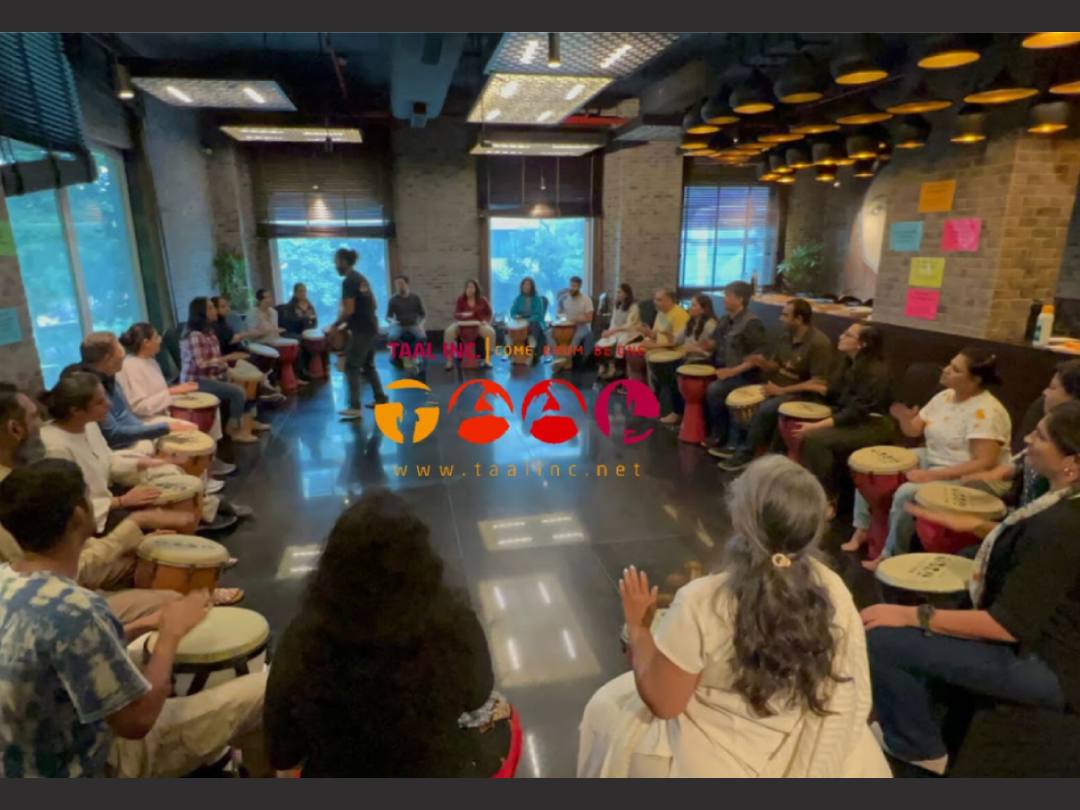There are various kinds of group drumming events. There’s cultural-festival-performance based group drumming, recreational community drum circles, corporate training drumming workshops and casual or informal drum jams. Which amongst these is the best drum circle for you? Well that would depend on the intent or objective of your gathering. Each of these activities serve a particular purpose. Let’s understand these four types of group drumming sessions a little better…
Culturally specific group drumming sessions
It’s the correct time to be talking about these sessions. Monsoons are here in Pune and the Ganpati festival is right around the corner. In fact, as I write this blog I can hear the sound of Dhols and Tashas in the distance as groups or ‘Pathaks’ as they are locally called are practicing to prepare their group to be ready for the drumming processions. They will lead their favourite deity as the idols are welcomed and eventually taken for immersion into the local, nearby water bodies. Here people regardless of age or gender may participate. They will be trained but eventually they must demonstrate a certain level of musicianship to be able to retain their spot in the group. This is a performance based community group drumming activity and hence even though the process may be very therapeutic and cathartic for many, there is an inclusion and retention criteria.
Recreational community drum circles
This is a more recent development. By recent, I mean over the last two decades, we’ve seen the existence and rise of community drum circles in and around our vicinity. This is usually a monthly activity where members of the community are welcome to gather together and drum. It does not matter whether they’ve touched a drum before or whether they possess a percussion instrument or not. Drums and instruments are usually provided. Other times the participants also carry their favourite drum. This way they know that they will always have a drum. The aim here is to drum together. Many times this can start with just some percussionists or musicians jamming together in a public park or venue. Gradually word spreads and where there is rhythm, there are people. As people gather there arises the need of a facilitator who will help those who don’t have experience or knowledge of the protocol of a drum circle to participate. This may entail sharing info of how to play the drum, certain do’s and don’ts and so on. It is now common for these sessions to follow the gift economy principle where participants pay as much as they feel at the end of the session. This helps to retain the authenticity of the spirit of a community drum circle. Do check out our social media (@taalinc) to know more about the next community drum circle near you.
Corporate drum circles or team building drum circles
These sessions are group drumming events that are specifically for a particular team. It is not open to the community. There is a unique objective; one that makes sense to the group that is being worked with. There is a trainer who has learned the art of drum circle facilitation from a teacher or a reputed institution. (We’ve got a course called ‘Find Your Inner Rhythm’ where you can learn how to become a drum circle facilitator and lead groups using rhythm). The facilitator introduces the drums, the objectives of the session and through each activity, connects the experience to the desired takeaways of the corporate training session. This becomes a unique, experience-based way of training as opposed to the usual one-way-communication, non-engaging corporate training sessions we are otherwise used to.
Informal drumming jams
As you may have already guessed, this is a casual ‘jam’ where 1 person, a small group or a large group of (usually) musicians or percussionists are jamming together. A semi-circular formation of drummers playing on the beaches of Goa during sunset is a perfect example of a drum jam. Here there’s usually no facilitator and the music created starts as easily as it stops. People come and go as per their convenience and availability. A small core group of drummers may be constant keeping the rhythm going. Some people may be dancing and some may be simply at a distance taking the vibrations in.
To sum it up, there are various shapes and forms that a corporate drum circle or a community drum circle or a recreational group drumming event can take. The best drum circles however are those that
- Help the participants feel welcome, safe and free
- Give the participants enough (precise and authentic) information about what the activity is and what it is not…
- Bring out the objective of the session from the participants in a strong, experiential and (when possible) measurable way
- Hold space for the participants to have their moments of expression, euphoria, realization, catharsis and even silence…
- Help you connect with the group rhythm as opposed to a specific person or leader
Do reach out to the expert team at Taal Inc. with your needs and we will be able to suggest the best way to engage your group at your event to bring out their potential in a real and memorable way.
Come. Drum. Be One
Varun Venkit

Varun is the founder and director of Taal Inc.
The visionary behind the motto
Come. Drum. Be One.
To read more about him Click Here

